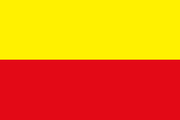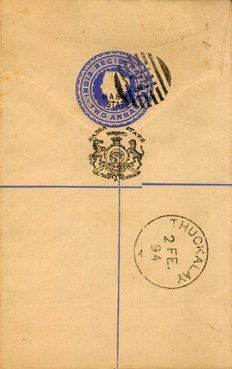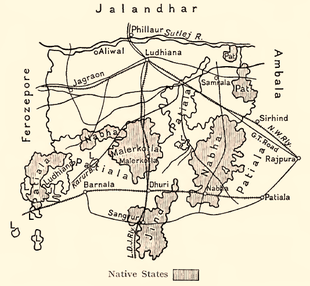Nabha (state)
| Nabha | |||||
| 1763-1948 | |||||
|
|||||
| Capital | Nabha | ||||
| Form of government | Princely state (13 shot salute) | ||||
| surface | 2453 km² | ||||
| population | 330,000 (1941) | ||||
| founding | 1763 | ||||
| resolution | August 20, 1948 | ||||
| State religion: Sikhism Dynasty: Sidhu Jat ( Phul ) |
|||||
| Map of Nabha (1911) | |||||
| Letter from the Nabha Post (1894) | |||||
| Nabha, Patiala , Jind , Malerkotla and the Ludhiana District in Punjab (1911) | |||||
Nabha was one of the Sikh - princely states in the then to Punjab associated foothills of the Himalayas in British India . It was founded in 1755 by Raja Hamir Singh, who belonged to the same dynasty as the princes of Patiala and Jind , and was named after its capital, Nabha .
Raja Jashwant Singh (r. 1783-1840) operated the expansion of the country while he was under reign as a minor , such as the return of lost areas of Jindh and the acquisition of parts of Malerkotlas in 1806 and 1808 from Khanna . When he did not provide any troops in the First Sikh War in 1845, he was deposed by the British. ¼ of the land was confiscated. Large parts of his land were ceded to Patiala and Faridkot , the taxes of another part were confiscated to entertain British troops, and all road tolls were abolished.
The British were supported financially in the Gurkha War in 1815 and in the Afghanistan War in 1838. Total tax revenue at that time 150,000 Rs., There were long-term border disputes with Patiala.
The incompetent Raja Davindar Singh was exiled with a pension of 50,000 Rs. Initially to Mathra , from 1855 Lahore , where he lived on a large scale. Bharpur Singh supported the British during the great Indian uprising of 1857 and in return received some land in return, with territorial gains worth Rs 106,000 in taxes, plus the right to 11 rounds of salute (May 1860). On the British side, the Phulkian States (Patiala, Jind and Nabha) were combined as an agency under the Government of the Punjab, which became part of the Punjab States Agency .
At the beginning of the 20th century, Nabha consisted of 12 patches of land, the population was about half Hindu, 31% Sikh and 18% Muslim. The country was divided into three districts ( nizamat ). Amloh in the north and Phul in the west were irrigated by the Sirhind Canal. The southern part, Bawal, was part of the Rajasthan desert .
In 1941 the area was 2,453 km² with 330,000 inhabitants. Maharaja Pratab Singh (1923–56) joined the Patiala and East Punjab States Union (PEPSU) on July 15, 1947, and joined India on August 20, 1948. On November 1, 1956, all princely states were dissolved and PEPSU part of the state of Punjab . The southernmost part came to the state of Haryana in 1966 .
The state had its own state post from 1885 to 1950. Due to the convention with the British-Indian Post, their postage stamps were used with the country's name printed (on postal stationery also coats of arms ).
Family tree of the dynasty
The ruling house of Nabha, like that of Patiala , Jind (h) , Bahawalpur, some smaller ones, descended from a son of Chaudari Phuls († 1652). In terms of protocol, the rulers of Nabhas ranked fourth among the princes of Punjab. (* = Main inheritance)
- 1st generation
- Thiloka († 1687)
- 5 younger brothers who each founded their own lines
- 2nd generation
- Gurdita († 1754)
- Sukhchen, founder of the Jind dynasty
- 3rd generation
- Suratya († 1752)
- 4th generation
- Kapur Singh
- * Hamir Singh († 1789). Founding of the place Nabha in 1755, actual "state foundation" in 1763 after being awarded the paragana Amloh.
- 5th generation
- Jaswat Singh (ruled 1783-1840, the widow Ranit Desu was regent until 1790. † 66 years old). Had five wives: Dya Kur, Chand Kur, Bam Kur, Har Kur, and Dharam Kur.
- 6th generation
- Kanwar Ranjit Singh, son of Dya Kurs († June 7, 1832), had three wives. Unloved by his father, who wanted to disinherit him, he died in the house of his (new) father-in-law under suspicious circumstances.
- * Davindar Singh, son of Har Kurs (= Deoindar Singh; * 1822, reigned October 5, 1840 to 1846; † November 1865 in Lahore), was a bigoted Sikh. His second wife (of four), the Rani Man Kur, was the mother of the two heirs to the family.
- 7th generation
- Bahapur Singh (= Bharpur Singh; * 1840, reigned Jan. 1847, in office 1857, † 1863) was a minor under the tutelage of his step-grandmother Chand Kur, Jaswat's widow, loyal to the uprising in 1857. He died childless, followed by his younger brother.
- Bhaghwan Singh (* 1842, † 1871) also died childless. According to the sanad of 1860 , his adopted successor was a jagirdar from Jind, also a descendant of Phul.
- 8th generation
- Hīra Singh, son of Bhaghwan (* 1841 or? 1843; ruled June 9 / August 10, 1871 to 1911), more conservative, but more upright, ruler. Full title from 1877: "His Highness Farzand-i-Abjumand Akidat Paiwand, Daulat-i-Inglishia Barar Bans Sarmur Sir Hira Singh, Maiwandar Bahadur, GCSI , Raja of Nabha"
- 9th generation
- Ripudaman Singh, (= Rapdaman Singh; * 1883, ruled from 1911, also increased rank to Maharaja), 1906–8 member of the Imperial Legislative Council . From 1921 right to 13 rounds of salute, 15 on site. He left his country in 1923 after allegations of kidnapping and illegal capture of Patiala's subjects. Resignation under British pressure in 1928.
- 10th generation
- Pratap Singh * September 21, 1919, reg. Feb. 19, 1928–1947, in office since March 1941, during the minority the state was under British administration. Journey to England 1932–34, then to Badingham College (with Leatherhead ), from 1938 cadet to the Sandhurst Military Academy
See also
literature
- William Barton: The princes of India. With a Chapter on Nepal. Nisbet, London 1934, (Reprinted edition. Cosmo, New Delhi 1983).
- Andreas Birken : Philatelic Atlas of British India. CD-ROM. Birken, Hamburg 2004.
- George B. Malleson: An historical sketch of the native states of India. Longmans, Green & Co., London 1875, ( digitized version ).
- Nābha State. In: The Imperial Gazetteer of India. Volume 18: Moram to Nayāgarh. New Edition. Clarendon Press, Oxford 1908, pp. 262-271 .
- Joseph E. Schwartzberg (Ed.): A historical atlas of South Asia (= Association for Asian Studies. Reference Series. 2). 2nd impression, with additional material. Oxford University Press, New York NY et al. 1992, ISBN 0-19-506869-6 .
Web links
- iiNet: Nabha (Princely State)
- Imperial Gazetteer of India
- http://www.uq.net.au/~zzhsoszy/ips/main.html
- http://www.worldstatesmen.org/India_princes_K-W.html
Individual evidence
- ^ Section (up to the 19th century) after: Charles Francis Massy: Chiefs and Families of Note in the Delhi, Jalandhar, Peshawar and Derajat Divisions of the Panjab. Pioneer Press, Allahabad 1890, pp. 28 ff.
- ↑ for 20th century: Jagdish C. Dua: Illustrated Encyclopaedia & Who's Who of Princely States in Indian Sub-Continent. Kaveri Books, New Delhi 2000, ISBN 81-7479-036-5 .
- ^ Roper Lethbridge: The Golden Book of India. A Genealogical and Biographical Dictionary of the Ruling Princes, Chiefs, Nobles, and other Personages, titled or decorated of the Indian Empire. Macmillan and Co., London 1893, p. 369 .




